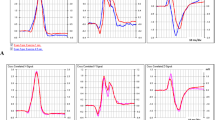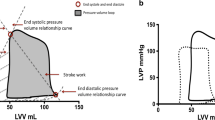Summary
The effect of coronary occlusion and reperfusion on myocardial electrical resistivity was studied in nine anesthetized open-chest dogs. Anisotropic resistivity was measured on the anterior free wall of the left ventricle (LV) before (control) and during transient occlusion of the left anterior descending (LAD) coronary artery, and during reperfusion. To measure local resistivity longitudinal (RL) and transverse (RT) to epicardial muscle fiber direction, a sensor was developed based on the four electrode (FE) technique with an electrode distance of 1 mm. Previous calculations showed that measurements with this system were confined to a 2-mm-thick epicardial layer. Control values for RL and RT were 243±32Ω·cm and 358±45Δ·cm (mean±SD, n=9) respectively. During a 2-min LAD occlusion, RL increased gradually by 12.4% (p<0.05) and RT by 7.8% (p<0.05) above the preceding control values. During a 5-min reperfusion period resistivities returned towards control values, but tended to remain elevated. RL showed a slight initial further increase during the first min of reperfusion and remained significantly above control values during 3 min of reperfusion. RT returned to values not significantly different from control after about 1 min of reperfusion.
Similar content being viewed by others
References
Baan J, Van der Velde ET, De Bruin H, Smeenk G, Koops J, Van Dijk AD, Temmerman D, Senden J, Buis B (1984) Continuous measurement of left ventricular volume in animals and man by conductance catheter. Circulation 70:812–823
Balke CW, Lesh MD, Spear JF, Kadish A, Levine JH, Moore EN (1988) Effects of cellular uncoupling on conduction in anisotropic canine ventricular myocardium. Circ Res 63:879–892
Bassingthwaighte JB, Yipintsoi T, Harvey RB (1974) Microvasculature of the dog left ventricular myocardium. Microvasc Res 7:229–249
Clerc L (1976) Directional differences of impulse spread in trabecular muscle from mammalian heart. J Physiol (Lond) 255:335–346
Cole KS (1969) Electrical analogs for tissues. Exp Neurology 24:459–473
Coronel R, Fiolet JWT, Wilms-Schopman FJG, Schaapherder AFM, Johnson TA, Gettes LS, Janse MJ (1988) Distribution of extracellular potassium and its relation to electrophysiologic changes during acute myocardial ischemia in the isolated perfused porcine heart. Circulation 77:1125–1138
Dominguez G, Fozzard HA (1970) Influence of extracellular K+ concentration on cable properties and excitability of sheep cardiac Purkinje fibers. Circ Res 26:565–574
Frank JS, Langer GA (1974) The myocardial interstitium: Its structure and its role in ionic exchange. J Cell Biol 60:586–601
Gettes LS (1986) Effects of ischemia on cardiac electrophysiology. In: Fozzard, Haber, Jennings, Katz, Morgan (eds) The heart and the cardiovascular system. Raven Press, New York, pp 1317–1341
Goerke J, Page E (1965) Cat heart in vitro: VI. Potassium exchange in papillary muscles. J Gen Physiol 48:933
Hellam D, Studt JW (1974) Linear analysis of membrane conductance and capacitance in cardiac Purkinje fibers. J Physiol London 243:661–694
Hill JL, Gettes LS (1980) Effect of acute coronary artery occlusion on local myocardial extracellular K+ activity in swine. Circulation 61:768–778
Hiramatsu Y, Buchanan JW, Knisley SB, Gettes LS (1988) Rate-dependent effects of hypoxia on longitudinal resistance in guinea pig papillary muscles. Circ Res 63:923–929
Hoffman EA, Ritman EL (1987) Intramyocardial blood volume — implications for analysis of myocardial mechanical characteristics via in vivo imaging of the heart. In: Sideman, Beyar (eds) Activation, metabolism and perfusion of the heart. Martinus Nijhoff, The Hague, pp 421–431
Katzung B, Morgenstern JA (1977) Effects of extracellular potassium on ventricular automaticity and evidence for a pacemaker current in mammalian ventricular myocardium. Circ Res 40:105–111
Kishida H, Surawicz B, Fu LT (1979) Effects of K+ and K+-induced polarization on (dV/dt)max, threshold potential, and membrane input resistance in guinea pig and cat ventricular myocardium. Circ Res 44:800–814
Kleber AG (1983) Resting membrane potential, extracellular potassium activity, and intracellular sodium activity during acute global ischemia in isolated perfused guinea pig hearts. Circ Res 52:442–450
Kleber AG, Janse MJ, Wilms-Schopmann FJG, Wilde AAM, Coronel R (1986) Changes in conduction velocity during acute ischemia in ventricular myocardium of the isolated porcine heart. Circulation 73:189–198
Kleber AG, Riegger CB, Janse MJ (1987) Electrical uncoupling and increase of extracellular resistance after induction of ischemia in isolated perfused rabbit papillary muscle. Circ Res 61:271–279
Miller WT, Geselowitz DG (1978) Simulation studies of the electrocardiogram, I. The normal heart. Circ Res 43:301–315
Mobley BA, Page E (1972) The surface area of sheep cardiac Purkinje fibers. J Physiol London 220:547–564
Morena H, Janse MJ, Fiolet JWT, Krieger WJG, Crijns H, Durrer D (1980) Comparison of the effects of regional ischemia, hypoxia, hyperkalemia, and acidosis on intracellular and extracellular potentials and metabolism in the isolated porcine heart. Circ Res 46:634–646
Morgenstern C, Holjes U, Arnold G, Lochner W (1973) The influence of coronary pressure and coronary flow on intracoronary blood volume and geometry of the left ventricle. Pflügers Arch 340:101–111
Muir A (1965) Further observations on the cellular structure of cardiac muscle. J Anat London 99:27–46
Plonsey R (1969) Bioelectric phenomena. McGraw Hill Book Co., New York
Plonsey R, Barr R (1982) The four-electrode resistivity technique as applied to cardiac muscle. IEEE Trans Biomed Eng 29:541–546
Plonsey R, Barr RC (1986) A critique of impedance measurements in cardiac tissue. Ann Biomed Eng 14:307–322
Roberts DE, Hersch LT, Scher AM (1979) Influence of cardiac fiber orientation on wavefront voltage, conduction velocity, and tissue resistivity in the dog. Circ Res 44:701–712
Roberts DE, Scher AM (1982) Effect of tissue anisotropy on extracellular potential fields in canine myocardium in situ. Circ Res 50:342–351
Roth BJ (1988) The electrical potential produced by a strand of cardiac muscle: a bidomain analysis. Ann Biomed Eng 16:609–637
Rush S, Abildskov JA, McFee R (1963) Resistivities of body tissues at low frequencies. Circ Res 12:40–50
Spach MS, Dolber PC (1986) Relating extracellular potentials and their derivatives to anisotropic propagation at a microscopic level in human cardiac muscle. Circ Res 58:356–371
Steendijk P, Van Dijk AD, Baan J (1987) Local myocardial perfusion monitored by electrical resistivity — an exploratory technique. In: Spaan, Bruschke, Gittenberger-de Groot (eds) Coronary circulation. Martinus Nyhoff, The Hague, pp 105–116
Streeter DD, Spotnitz HM, Patel DP, Ross J, Sonnenblick EH (1969) Fiber orientation in the canine left ventricle during diastole and systole. Circ Res 24:339–347
Tillmanns H, Leinberger H, Neumann FJ, Steinhausen M, Parekh N, Zimmermann R (1984) Early microcirculatory changes during brief ischemia — primary events in ischemic myocardial injury? Circulation 70:(Suppl II) 88
Tillmanns H, Steinhausen M, Leinberger H, Thederan H, Kuebler W (1981) Hemodynamics of the coronary microcirculation during myocardial ischemia. Circulation 64:40
Tranum-Jensen J, Janse MJ, Fiolet JWT, Krieger WJG, d'Alnoncourt CN, Durrer D (1981) Tissue osmolality, cell swelling, and reperfusion in acute regional myocardial ischemia in the isolated porcine heart. Circ Res 49:364–381
Van Oosterom A, De Boer RW, Van Dam RT (1979) Intramural resistivity of cardiac tissue. Med & Biol Eng & Comput 17:337–343
Vergroesen I, Noble MIM, Spaan JAE (1987) Intramyocardial blood volume change in the first moments of cardiac arrest in anesthetized goats. Am J Physiol 253:H307-H316
Wangerl D, Peters K, Laughlin D, Tomanck R, Marcus M (1981) A method for continuously assessing coronary blood flow velocity in the rat. Am J Physiol 241:H816-H820
Weidmann S (1970) Electrical constants of trabecular muscle from mammalian heart. J Physiol 210:1041–1054
Weiss J, Shine KI (1982) [K+]o accumulation and electrophysiological alterations during early myocardial ischemia. Am J Physiol 243:H318-H327
Wojtczak J (1979) Contractures and increase in internal longitudinal resistance of cow ventricular muscle induced by hypoxia. Circ Res 44:88–95
Zar JH (1984) Biostatistical Analysis. Prentice Hall, New Jersey
Author information
Authors and Affiliations
Rights and permissions
About this article
Cite this article
Steendijk, P., van Dijk, A.D., Mur, G. et al. Effect of coronary occlusion and reperfusion on local electrical resistivity of myocardium in dogs. Basic Res Cardiol 88, 167–178 (1993). https://doi.org/10.1007/BF00798265
Received:
Accepted:
Issue Date:
DOI: https://doi.org/10.1007/BF00798265




